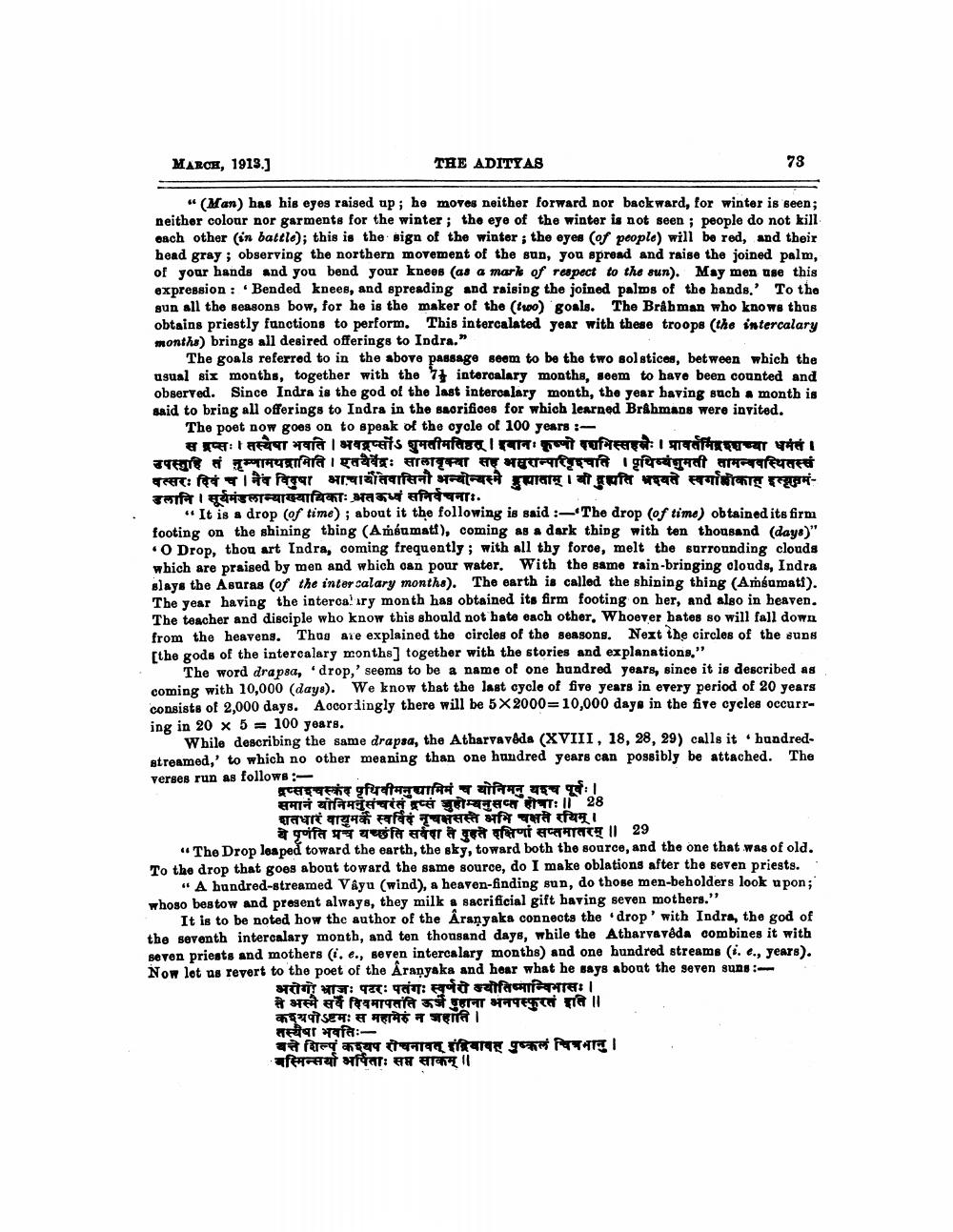________________
THE ADITYAS
MARCH, 1913.]
"(Man) has his eyes raised up; he moves neither forward nor backward, for winter is seen; neither colour nor garments for the winter; the eye of the winter is not seen; people do not kill each other (in battle); this is the sign of the winter; the eyes (of people) will be red, and their head gray; observing the northern movement of the sun, you spread and raise the joined palm, of your hands and you bend your knees (as a mark of respect to the sun). May men use this expression: Bended knees, and spreading and raising the joined palms of the hands.' To the sun all the seasons bow, for he is the maker of the (two) goals. The Brahman who knows thus obtains priestly functions to perform. This intercalated year with these troops (the intercalary months) brings all desired offerings to Indra."
73
The goals referred to in the above passage seem to be the two solstices, between which the usual six months, together with the 7 intercalary months, seem to have been counted and observed. Since Indra is the god of the last intercalary month, the year having such a month is said to bring all offerings to Indra in the sacrifices for which learned Brahmans were invited.
The poet now goes on to speak of the cycle of 100 years :
स द्रप्सः । तस्यैषा भवतेि । भवतुप्सोंऽ शुमतीमतिष्ठत् । इवानः कृष्णो दद्यभिस्सहलेः । प्रावर्तनिद्रश्शच्या धर्मतं । उपस्तुहि तं नृम्णामयद्रामिति । एतयैवेंद्रः सालावृक्या सह असुरान्परिवृश्चति । पृथिव्यंशुमती तामन्ववस्थितस्सं वत्सरः दिवं च | नैव विदुषा आचायतवासिनो अन्योन्यस्मै मुस्याताम् । यो दुश्यति भश्वते स्वर्गाश्लोकात इल्यूमडलानि । सूर्यमंडलाम्याख्यायिकाः भतकभ्यं सनिर्वचनाः.
"It is a drop (of time); about it the following is said :-The drop (of time) obtained its firm footing on the shining thing (Améumati), coming as a dark thing with ten thousand (days)" O Drop, thou art Indra, coming frequently; with all thy force, melt the surrounding clouds which are praised by men and which can pour water. With the same rain-bringing clouds, Indra slays the Asuras (of the intercalary months). The earth is called the shining thing (Améumati). The year having the intercalary month has obtained its firm footing on her, and also in heaven. The teacher and disciple who know this should not hate each other. Whoever hates so will fall down from the heavens. Thus are explained the circles of the seasons. Next the circles of the suns [the gods of the intercalary months] together with the stories and explanations."
The word drapsa, 'drop,' seems to be a name of one hundred years, since it is described as coming with 10,000 (days). We know that the last cycle of five years in every period of 20 years consists of 2,000 days. Accordingly there will be 5X2000=10,000 days in the five cycles occurring in 20 x 5 = 100 years.
While describing the same drapsa, the Atharvaveda (XVIII, 18, 28, 29) calls it hundredstreamed,' to which no other meaning than one hundred years can possibly be attached. The verses run as follows:
इप्सचस्कंद पृथिवीमनुधामिमं च योनिमनु यश्च पूर्वः । समानं योनिमनुचरंतं द्रप्तं जुहोम्बनुसप्त होगाः ॥ 28 शतधारं वायुमकै स्वर्विदं नृचक्षसस्ते अभि चक्षते रयिम् ।
ये पृणति प्रत्र यच्छंति सर्वदा ते दुहते दक्षिणां सप्तमातरम् | 29
"The Drop leaped toward the earth, the sky, toward both the source, and the one that was of old. To the drop that goes about toward the same source, do I make oblations after the seven priests.
"A hundred-streamed Vâyu (wind), a heaven-finding sun, do those men-beholders look upon; whoso bestow and present always, they milk a sacrificial gift having seven mothers."
It is to be noted how the author of the Aranyaka connects the drop' with Indra, the god of the seventh intercalary month, and ten thousand days, while the Atharvavêda combines it with seven priests and mothers (i. e., seven intercalary months) and one hundred streams (i. e., years). Now let us revert to the poet of the Aranyaka and hear what he says about the seven suns:
अरोगो भ्राजः पटरः पतंगः स्वर्णरो ज्योतिष्मान्विभासः । ते अस्मै सर्वे दिवमापतति ऊर्जे बुहाना अनपस्फुरतं इति ।। कश्यपोऽष्टमः स महामेरुं न जहाति ।
तस्यैषा भवतिः
बन्ते शिल्पं कश्यप रोचनावत् इंद्रियागत पुष्कलं चित्रभानु | 'बस्मिन्सर्या अर्पिताः सप्त साकम् ||




